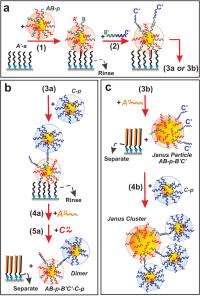DNA-Based Assembly Line for Nano-Construction of New Biosensors, Solar Cells (w/Video)

(√»√√…Á«¯Org.com) -- Building on the idea of using DNA to link up nanoparticles ‚Äî particles measuring mere billionths of a meter ‚Äî scientists at the U.S. Department of Energy‚Äôs Brookhaven National Laboratory have designed a molecular assembly line for predictable, high-precision nano-construction. Such reliable, reproducible nanofabrication is essential for exploiting the unique properties of nanoparticles in applications such as biological sensors and devices for converting sunlight to electricity. The work will be published online March 29, 2009, by Nature Materials.
The Brookhaven team has previously used DNA, the molecule that carries life’s genetic code, to link up nanoparticles in various arrangements, including 3-D nano-crystals. The idea is that nanoparticles coated with complementary strands of DNA — segments of genetic code sequence that bind only with one another like highly specific Velcro — help the nanoparticles find and stick to one another in highly specific ways. By varying the use of complementary DNA and strands that don’t match, scientists can exert precision control over the attractive and repulsive forces between the nanoparticles to achieve the desired construction. Note that the short DNA linker strands used in these studies were constructed artificially in the laboratory and don’t “code” for any proteins, as genes do.
The latest advance has been to use the DNA linkers to attach some of the DNA-coated nanoparticles to a solid surface to further constrain and control how the nanoparticles can link up. This yields even greater precision, and therefore a more predictable, reproducible high-throughput construction technique for building clusters from nanoparticles.
“When a particle is attached to a support surface, it cannot react with other molecules or particles in the same way as a free-floating particle,” explained Brookhaven physicist Oleg Gang, who led the research at the Lab’s Center for Functional Nanomaterials. This is because the support surface blocks about half of the particle’s reactive surface. Attaching a DNA linker or other particle that specifically interacts with the bound particle then allows for the rational assembly of desired particle clusters.
“By controlling the number of DNA linkers and their length, we can regulate interparticle distances and a cluster’s architecture,” said Gang. “Together with the high specificity of DNA interactions, this surface-anchored technique permits precise assembly of nano-objects into more complex structures.”
Instead of assembling millions and millions of nanoparticles into 3-D nanocrystals, as was done in the previous work, this technique allows the assembly of much smaller structures from individual particles. In the Nature Materials paper, the scientists describe the details for producing symmetrical, two-particle linkages, known as dimers, as well as small, asymmetrical clusters of particles — both with high yields and low levels of other, unwanted assemblies.

“When we arrange a few nanoparticles in a particular structure, new properties can emerge,” Gang emphasized. “Nanoparticles in this case are analogous to atoms, which, when connected in a molecule, often exhibit properties not found in the individual atoms. Our approach allows for rational and efficient assembly of nano-‘molecules.’ The properties of these new materials may be advantageous for many potential applications.”
For example, in the paper, the scientists describe an optical effect that occurs when nanoparticles are linked as dimer clusters. When an electromagnetic field interacts with the metallic particles, it induces a collective oscillation of the material’s conductive electrons. This phenomenon, known as a plasmon resonance, leads to strong absorption of light at a specific wavelength.
“The size and distance between the linked particles affect the plasmonic behavior,” said Gang. By adjusting these parameters, scientists might engineer clusters for absorbing a range of wavelengths in solar-energy conversion devices. Modulations in the plasmonic response could also be useful as a new means for transferring data, or as a signal for a new class of highly specific biosensors.
Asymmetric clusters, which were also assembled by the Brookhaven team, allow an even higher level of control, and therefore open new ways to design and engineer functional nanomaterials.
Because of its reliability and precision control, Brookhaven’s nano-assembly method would be scalable for the kind of high-throughput production that would be essential for commercial applications. Brookhaven Lab has applied for a patent on the assembly method as well as several specific applications of the technology.
Provided by Brookhaven National Laboratory

















